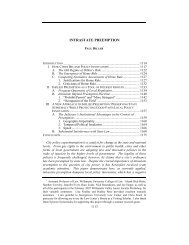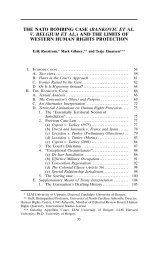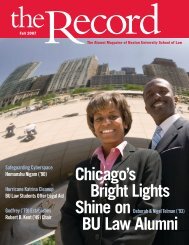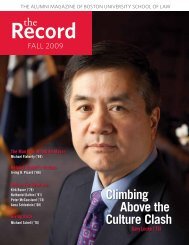the nature of representation: the cherokee right ... - Boston University
the nature of representation: the cherokee right ... - Boston University
the nature of representation: the cherokee right ... - Boston University
You also want an ePaper? Increase the reach of your titles
YUMPU automatically turns print PDFs into web optimized ePapers that Google loves.
146 PUBLIC INTEREST LAW JOURNAL [Vol. 15<br />
“democratic <strong>representation</strong> cannot be understood purely and exclusively in terms <strong>of</strong><br />
one person, one vote,” this idea was in part what was behind Clinton’s withdrawal<br />
<strong>of</strong> Guinier’s nomination to head <strong>the</strong> Department <strong>of</strong> Justice’s Civil Rights<br />
Division. 276 The Supreme Court has only tangentially considered <strong>the</strong> issues raised<br />
by a tribal representative. Although <strong>the</strong> Supreme Court in Cherokee Nation v.<br />
Georgia re-characterized <strong>the</strong> deputy promise as an agent promise, it did not discuss<br />
or rule on <strong>the</strong> constitutionality <strong>of</strong> a tribal representative. Popularly, “equal<br />
protection” is equated with equal voting <strong>right</strong>s, an idea to which Justice Harlan<br />
responded in a dissenting opinion to a state legislative districting case:<br />
[T]he Court’s argument boils down to <strong>the</strong> assertion that appellees’ <strong>right</strong> to<br />
vote has been invidiously “debased” or “diluted” by systems <strong>of</strong><br />
apportionment which entitle <strong>the</strong>m to vote for fewer legislators than o<strong>the</strong>r<br />
voters, an assertion which is tied to <strong>the</strong> Equal Protection Clause only by <strong>the</strong><br />
constitutionally frail tautology that “equal” means “equal.” 277<br />
The assertion that dilution <strong>of</strong> voting <strong>right</strong>s amounts to a denial <strong>of</strong> equal protection<br />
is particularly relevant for <strong>the</strong> Cherokees, for through <strong>the</strong> Cherokee delegate, non-<br />
Cherokees would see <strong>the</strong>ir <strong>representation</strong>al <strong>right</strong>s diluted.<br />
The U.S. Constitution as originally passed explicitly allowed racial and<br />
geographic super-votes. Article I, § 2 <strong>of</strong> <strong>the</strong> U.S. Constitution reads:<br />
Representatives and direct Taxes shall be apportioned among <strong>the</strong> several<br />
States which may be included within this Union, according to <strong>the</strong>ir respective<br />
Numbers, which shall be determined by adding to <strong>the</strong> whole Number <strong>of</strong> free<br />
Persons, including those bound to Service for a Term <strong>of</strong> Years, and excluding<br />
Indians not taxed, three fifths <strong>of</strong> all o<strong>the</strong>r Persons.<br />
According to <strong>the</strong> Constitution only whites mattered, Indians were not included,<br />
and African-Americans, euphemistically called “all o<strong>the</strong>r Persons,” were counted as<br />
3/5ths persons. This system gave whites a super-vote relative to <strong>the</strong> electoral<br />
exclusion <strong>of</strong> Indians and African-Americans. 278 Additionally, through this<br />
apportionment scheme, Sou<strong>the</strong>rn whites, as a group, enjoyed a super-vote relative<br />
to Nor<strong>the</strong>rn whites. 279 Thus, historically, <strong>the</strong> US has given certain groups supervotes<br />
in <strong>the</strong> past and this should be kept in mind when considering <strong>the</strong> Cherokee<br />
delegate <strong>right</strong>.<br />
276 Lani Guinier, More Democracy, 1995 U. CHI.LEGAL F. 1, 7 (1995).<br />
277 Reynolds v. Sims, 377 U.S. 533, 590 (1964) (Harlan, J., dissenting).<br />
278 See, JUAN F. PEREA ET AL., RACE AND RACES: CASES AND RESOURCES FOR A DIVERSE<br />
AMERICA 583-584 (2000) (discussing <strong>the</strong> idea that whites were <strong>the</strong> only group worthy<br />
<strong>of</strong> citizenship).<br />
279 To illustrate this, consider <strong>the</strong> apportionment <strong>of</strong> representatives given <strong>the</strong><br />
following hypo<strong>the</strong>tical populations: Sou<strong>the</strong>rn states have 10,000 whites and 5,000<br />
African-Americans; Nor<strong>the</strong>rn states have 13,000 whites. Taking into account <strong>the</strong> effect<br />
<strong>of</strong> Article I, § 2 apportionment, 10,000 Sou<strong>the</strong>rn whites would have as many<br />
representatives as <strong>the</strong> 13,000 Nor<strong>the</strong>rn whites. Of course, individual Sou<strong>the</strong>rn whites<br />
would still be voting for only a single representative in each election.









